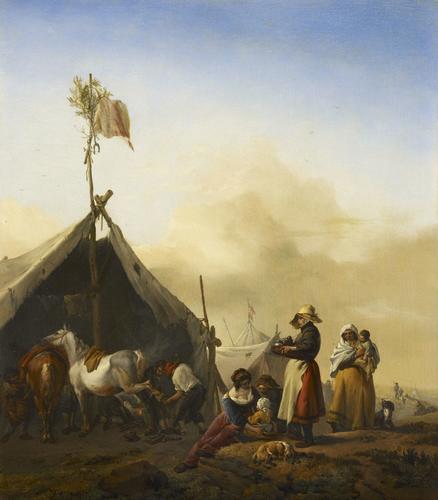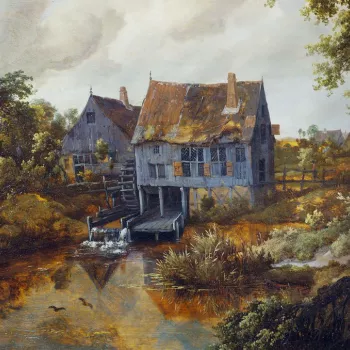The Farrier of the Camp c.1650
Oil on panel | 37.4 x 32.2 cm (support, canvas/panel/stretcher external) | RCIN 404809
-
Philips Wouwermans (1619-68) spent his life in Haarlem, though briefly visiting Hamburg in 1638 or 1639. Wouwermans’s early work is reminiscent of that of Isaac van Ostade and the influence of the Haarlem tonal school persists throughout his career in effects of soft light filtered through misty skies and in the thinly painted areas allowing brown underpaint to show through. His later work has bluer skies, and a more silvery overall tonality as well as including more elegant figures.
This relatively early work by Philips Wouwermans shows how he departs from the imagery of Isaac van Ostade. In the first place the scene is more remote and threatening: a collection of makeshift tents on a rough dune landscape, set up by camp-followers in order to profit from soldiers billeted nearby. Such opportunistic encampments are visible, for example, in the middle ground of Jacques Callot’s 'Siege of Breda' in the British Museum. The farrier’s tent is advertised by a horseshoe on its flagpole; the farrier himself shoes a horse, while a sutler from a neighbouring tent brings a pot of ale. Various women (perhaps soldiers’ ‘wives’) clutch babies. These figures are individualised and distinctly drawn and the heroine stands out against the sky in dramatic silhouette. These strangely imposing figures – part heroic, part grotesque – derive from Pieter van Laer, a Haarlem artist, who worked in Rome and who created the prototypes for the menacing street-loiterers seen in the work of Lingelbach and du Jardin (RCIN 404534 and 406208), before returning home in 1639. Wouwermans was said to have owned a collection of studies that van Laer had made in Rome. Reynolds clearly noticed the force of van Lear’s drawing with the brush, referring to his ‘correct, firm, and determined pencil [paintbrush]’ which might have been employed on more elevated subjects than he chose.
Wouwermans’s principal figure is also reminiscent of another monstrous heroine, one of Jacques Callot’s beggars, from a series of etchings of 1622–3 (The British Museum), especially in the way in which her form seems to be stitched together from rags and driftwood. It is no accident that this redoubtable camp-follower reminds us of ‘Mother Courage’, a character who first appeared in 1669 in a novel, 'Die Lebensbeschreibung der Erzbetrügerin und Landstörtzerin Courasche' (The Life of the Arch-Swindler and Gypsy Courage), by Hans Jacob Christoph von Grimmelshausen.Provenance
Purchased by George IV from Sir Thomas Baring as part of a group of 86 Dutch and Flemish paintings, most of which were collected by Sir Thomas’s father, Sir Francis Baring; they arrived at Carlton House on 6 May 1814; recorded in the anti-room to the Dining Room at Carlton House in 1819 (no 82); in the Picture Gallery at Buckingham Palace in 1841 (no 21)
-
Medium and techniques
Oil on panel
Measurements
37.4 x 32.2 cm (support, canvas/panel/stretcher external)
55.0 x 50.0 x 5.0 cm (frame, external)
Other number(s)









